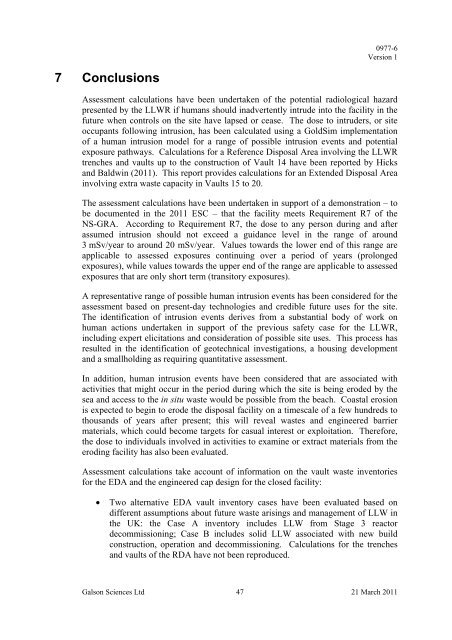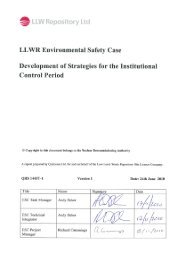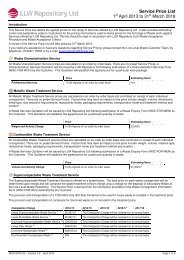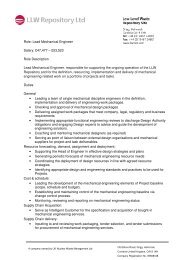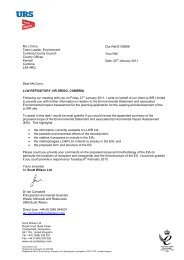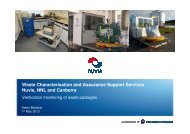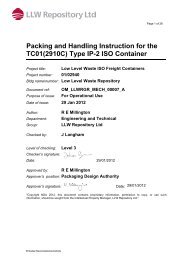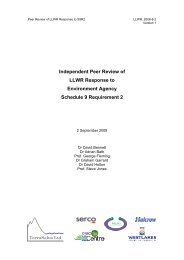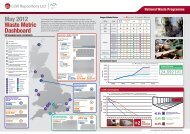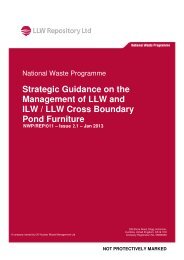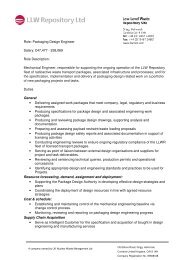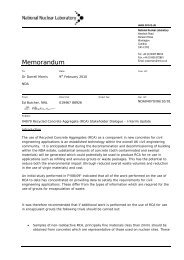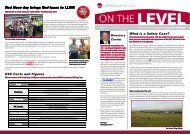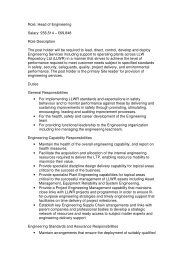Baldwin TD and Hicks TW, Assessment Calculations for Human ...
Baldwin TD and Hicks TW, Assessment Calculations for Human ...
Baldwin TD and Hicks TW, Assessment Calculations for Human ...
Create successful ePaper yourself
Turn your PDF publications into a flip-book with our unique Google optimized e-Paper software.
0977-6Version 17 Conclusions<strong>Assessment</strong> calculations have been undertaken of the potential radiological hazardpresented by the LLWR if humans should inadvertently intrude into the facility in thefuture when controls on the site have lapsed or cease. The dose to intruders, or siteoccupants following intrusion, has been calculated using a GoldSim implementationof a human intrusion model <strong>for</strong> a range of possible intrusion events <strong>and</strong> potentialexposure pathways. <strong>Calculations</strong> <strong>for</strong> a Reference Disposal Area involving the LLWRtrenches <strong>and</strong> vaults up to the construction of Vault 14 have been reported by <strong>Hicks</strong><strong>and</strong> <strong>Baldwin</strong> (2011). This report provides calculations <strong>for</strong> an Extended Disposal Areainvolving extra waste capacity in Vaults 15 to 20.The assessment calculations have been undertaken in support of a demonstration – tobe documented in the 2011 ESC – that the facility meets Requirement R7 of theNS-GRA. According to Requirement R7, the dose to any person during <strong>and</strong> afterassumed intrusion should not exceed a guidance level in the range of around3 mSv/year to around 20 mSv/year. Values towards the lower end of this range areapplicable to assessed exposures continuing over a period of years (prolongedexposures), while values towards the upper end of the range are applicable to assessedexposures that are only short term (transitory exposures).A representative range of possible human intrusion events has been considered <strong>for</strong> theassessment based on present-day technologies <strong>and</strong> credible future uses <strong>for</strong> the site.The identification of intrusion events derives from a substantial body of work onhuman actions undertaken in support of the previous safety case <strong>for</strong> the LLWR,including expert elicitations <strong>and</strong> consideration of possible site uses. This process hasresulted in the identification of geotechnical investigations, a housing development<strong>and</strong> a smallholding as requiring quantitative assessment.In addition, human intrusion events have been considered that are associated withactivities that might occur in the period during which the site is being eroded by thesea <strong>and</strong> access to the in situ waste would be possible from the beach. Coastal erosionis expected to begin to erode the disposal facility on a timescale of a few hundreds tothous<strong>and</strong>s of years after present; this will reveal wastes <strong>and</strong> engineered barriermaterials, which could become targets <strong>for</strong> casual interest or exploitation. There<strong>for</strong>e,the dose to individuals involved in activities to examine or extract materials from theeroding facility has also been evaluated.<strong>Assessment</strong> calculations take account of in<strong>for</strong>mation on the vault waste inventories<strong>for</strong> the EDA <strong>and</strong> the engineered cap design <strong>for</strong> the closed facility:• Two alternative EDA vault inventory cases have been evaluated based ondifferent assumptions about future waste arisings <strong>and</strong> management of LLW inthe UK: the Case A inventory includes LLW from Stage 3 reactordecommissioning; Case B includes solid LLW associated with new buildconstruction, operation <strong>and</strong> decommissioning. <strong>Calculations</strong> <strong>for</strong> the trenches<strong>and</strong> vaults of the RDA have not been reproduced.Galson Sciences Ltd 47 21 March 2011


